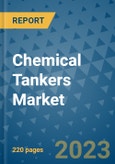The global chemical tankers market is poised for significant growth, fueled by the surge in economic activity and the rise in sea-borne trade post the COVID-19 pandemic. As international lockdowns were lifted and trading activities resumed, the chemical sector witnessed an upswing in manufacturing and trading, particularly from developing economies. The import and export of chemicals surged past 2021, leading to notable economic development and creating substantial opportunities for the maritime trading sector. Sea transport remains the preferred and cost-effective medium for delivering cargo over longer distances, making chemical tankers a crucial player in facilitating this trade.
According to the United Nations Conference on Trade and Development (UNCTAD), more than 80% of international trade volume is conducted by sea, and the World Trade Organization reported that seaborne trade significantly exceeded its pre-pandemic levels in the first two quarters of 2021.
The demand for chemical tankers is further boosted by changing trade flows. For instance, the Russian invasion of Ukraine prompted several countries, including some in Europe, to impose strict international sanctions against Russia, halting Russian exports. As a result, Russian exports shifted to short-haul routes, leading to an increase in demand for tonnage and a surge in miles per hour. This shift in trade flows benefited other countries, which witnessed a boost in their exports via sea trade, further driving the chemical tankers market.
IMO II Chemical Tankers to Account for Major Revenue Share in Chemical Tankers Market
Among the various types of chemical tankers, the demand for IMO II chemical tankers has seen significant growth and is expected to continue its upward trajectory. These tankers are specifically designed for the transportation of chemicals that require rigorous preventive measures. They are also used for bulk chemicals such as animal/vegetable oils, bio-based lubricants, methanol, alkenes, ethanol, and other hazardous materials. The adoption of IMO II tankers has contributed substantially to the overall value growth of the chemical tankers market.
Asia Pacific to Emerge as a Potential Hotbed of Opportunities for Chemical Tankers Market
The Asia Pacific region is set to lead the chemical tankers market in the coming years, driven by the accelerated growth in the refining and petrochemical industries. Countries like China and India are expected to account for a significant share in the market. India, in particular, stands as the largest importer and second-largest consumer of edible oil globally. With a growing chemical industry, India's demand for chemical tankers has witnessed an upsurge, with significant exports of inorganic and organic chemicals recorded in recent times. Additionally, major shipbuilding hubs in Asia, such as Korea, China, and Japan, contribute to the region's dominance in the chemical tankers market.
Chemical Tankers Market: Competition Scenario
The chemical tankers market is witnessing intense competition and dynamic developments, characterized by acquisitions, new launches, collaborations, partnerships, and increased research and development activities. Key players in the market are striving to strengthen their positions and expand their operations to cater to the growing demand.
Some prominent players in the global chemical tankers market include Stolt-Nielsen, Bahri Chemicals, Odfjell SE, Seatrans Chemical Tankers, Navig8 Chemicals, Nordic Tankers, Wilmar International, Tokyo Marine Asia Pte Ltd., Mitsui O.S.K Lines, Nanjing Shenghang Shipping Co. Ltd., and IINO Kaiun Kaisha Ltd.
Table of Contents
Companies Mentioned
- Stolt-Nielsen Limited
- Odfjell SE
- Nordic Tankers A/S
- Navig8 Group
- MOL Chemical Tankers Ltd.
- Sinochem Group
- Team Tankers International Ltd.
- Bahri (National Shipping Company of Saudi Arabia)
- UNI-TANKERS A/S
- WOMAR Tanker Pools
- Ace Tankers
- HANSA Tankers
- The IINO Kaiun Kaisha, Ltd.








